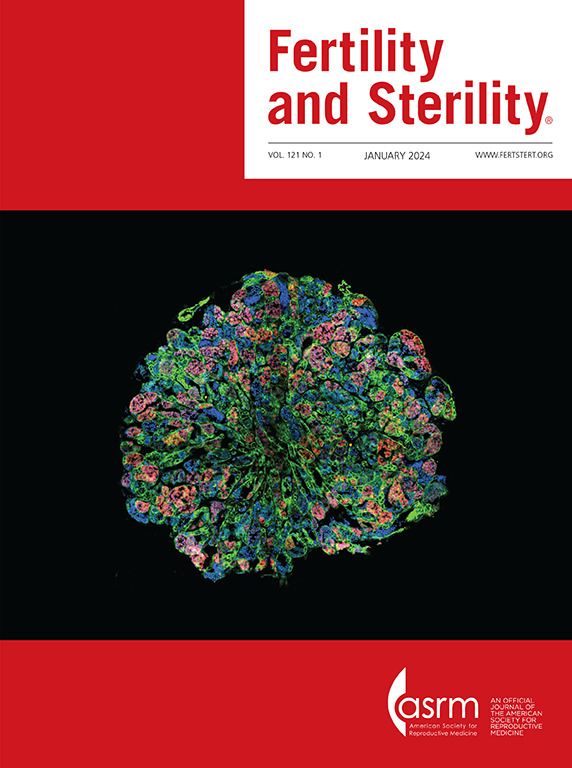关于完善和扩展个体化卵巢刺激疗法关键绩效指标的专家意见。
IF 6.6
1区 医学
Q1 OBSTETRICS & GYNECOLOGY
引用次数: 0
摘要
目的评估卵巢刺激(OS)开始前卵巢潜能(前卵泡计数[AFC])与卵母细胞获取时的卵母细胞数量和质量之间的充分卵泡发育和卵母细胞恢复情况。对目前的关键绩效指标(KPIs)进行了全面概述,以确定优势互补之处,并确定可在哪些方面扩大目前的范围:设计:专家意见:干预措施:无:干预措施:无:主要结果测量:为辅助生殖技术个体化操作系统的KPI指标库的完善和扩展提出建议:结果:OS对卵巢卵泡发育的性能和结果可通过应用定义的关键绩效指标进行评估。OS 目前的关键绩效指标包括卵巢敏感性指数 (OSI)、卵泡产出率 (FORT)、卵母细胞获取率 (ORR) 和卵泡至卵母细胞指数 (FOI)。值得注意的是,没有专门用于评估卵泡发育(即招募、选择、生长和优势)的特定 KPI。有鉴于此,我们建议扩大 OS 目前的 KPI 指标,以包括 "早期 FORT"(OS 第 5/6 天测量值≥10-11 mm 的卵泡数量与 AFC 的比值)和 "修正 FORT"(卵母细胞成熟触发时测量值≥12 mm 的卵泡数量与 AFC 的比值);扩大 ORR,以包括卵母细胞取回时的两个不同类别:≥12毫米的卵泡和≥16毫米的卵泡,以确保所有有反应的卵泡都被计算在内;在卵母细胞成熟触发和卵母细胞取出时测量FOI("高级FOI")。得出结论:我们设想,一旦经过验证并在临床实践中采用,所提出的衡量操作系统对卵泡发育(募集、选择、生长和优势)影响的扩展关键绩效指标将加深对 AFC 所衡量的卵巢储备与卵母细胞取回时的卵母细胞数量和质量之间关系的理解。有了这种认识,医生就能更好地评估不同促性腺激素和剂量对卵巢反应的直接影响,从而在抗逆转录病毒疗法中采用更个性化的 OS 方法。本文章由计算机程序翻译,如有差异,请以英文原文为准。
Expert opinion on refined and extended key performance indicators for individualized ovarian stimulation for assisted reproductive technology
Objective
To assess the adequate ovarian follicular development and oocyte recovery between ovarian potential (antral follicle count [AFC]) before the start of ovarian stimulation (OS) and oocyte quantity and quality at oocyte retrieval. A holistic overview of the current key performance indicators (KPIs) was applied to identify the complementary strengths and identify where the current repertoire can be expanded.
Design
Expert opinion.
Intervention
None.
Main Outcome Measures
To formulate a proposal for a refined and expanded repertoire of KPIs for individualized OS for assisted reproductive technology.
Results
The performance and outcomes of OS on ovarian follicular development can be evaluated through the application of defined KPIs. Current KPIs for OS are the ovarian sensitivity index, follicular output rate (FORT), oocyte retrieval rate, and follicle-to-oocyte index (FOI). Notably, there are no specific KPIs dedicated to the assessment of follicular development (i.e., recruitment, selection, growth, and dominance). In light of this, we recommend expanding the current KPIs for OS to include “early FORT” (accounting for the number of follicles measuring ≥10 to 11 mm on day 5/6 of OS relative to AFC) and “modified FORT” (the ratio between the number of follicles measuring ≥12 mm at the time of oocyte maturation triggering and AFC); the extension of oocyte retrieval rate to include two discrete categories at oocyte retrieval—follicles measuring ≥12 mm and ≥16 mm—to ensure that all responsive follicles are accounted for; and FOI to be measured at oocyte maturation triggering and oocyte retrieval ("advanced FOI”).
Conclusion
Once validated and adopted in clinical practice, we envisage that the proposed expanded KPIs measuring the effect of OS on follicular development (recruitment, selection, growth, and dominance) will increase the understanding of the relationship between ovarian reserve, measured by AFC, and oocyte quantity and quality at oocyte retrieval. This understanding will enable physicians to better evaluate the direct effect of different gonadotropins and doses on ovarian response, leading to a more personalized approach to OS in the context of assisted reproductive technology treatment.
Opinión de expertos sobre indicadores clave y refinados de desempeño extendidos para estimulación ovárica individualizada para tecnología de reproducción asistida.
Objetivo
Evaluar el desarrollo folicular ovárico adecuado y la recuperación de ovocitos entre el potencial ovárico (recuento de folículos antrales [AFC]) antes del inicio de la estimulación ovárica (EO) y la cantidad y calidad de ovocitos en la aspiración ovocitaria. Se aplicó una descripción holística de los indicadores clave de desempeño (KPI) actuales para identificar las fortalezas complementarias e identificar dónde el repertorio actual puede ser expandido.
Diseño
Opinión de expertos.
Intervenciones
Ninguna.
Principales Medidas de Resultados
Formular una propuesta para un repertorio refinado y ampliado de KPIs para la EO individualizada para tecnología de reproducción asistida.
Resultados
El desempeño y los resultados de la EO en el desarrollo folicular ovárico se pueden evaluar mediante la aplicación de KPIs definidos. Los KPIs actuales para la EO son el índice de sensibilidad ovárica, la tasa de producción folicular (FORT), la tasa de recuperación de ovocitos y el índice folículo-ovocito (FOI). Cabe destacar que no existen KPIs específicos dedicados a la evaluación del desarrollo folicular (es decir, reclutamiento, selección, crecimiento y dominancia). En vista de esto, recomendamos ampliar los KPIs actuales para la EO para incluir la “FORT temprana” (considerando el número de folículos que miden ≥10 a 11 mm en el día 5/6 de EO en relación con el AFC) y la “FORT modificada” (la relación entre el número de folículos que miden ≥12 mm en el momento de la activación de la maduración de los ovocitos y el AFC); la extensión de la tasa de recuperación de ovocitos para incluir dos categorías discretas en la aspiración ovocitaria - folículos que miden ≥12 mm y ≥16 mm - para garantizar que todos los folículos receptivos sean contabilizados; y FOI se medirá en el momento que se desencadena de la maduración de los ovocitos y en la aspiración ovocitaria ("FOI avanzado").
Conclusión
Una vez validados y adoptados en la práctica clínica, prevemos que los KPIs ampliados propuestos que miden el efecto de la EO sobre el desarrollo folicular (reclutamiento, selección, crecimiento y dominancia) aumentará la comprensión de la relación entre la reserva ovárica, medida por AFC, y la cantidad y calidad de los ovocitos en la aspiración ovocitaria. Esta comprensión permitirá a los médicos evaluar mejor el efecto directo de diferentes gonadotropinas y dosis en la respuesta ovárica, lo que conducirá a un abordaje más personalizado para la EO en el contexto del tratamiento de tecnología de reproducción asistida.
求助全文
通过发布文献求助,成功后即可免费获取论文全文。
去求助
来源期刊

Fertility and sterility
医学-妇产科学
CiteScore
11.30
自引率
6.00%
发文量
1446
审稿时长
31 days
期刊介绍:
Fertility and Sterility® is an international journal for obstetricians, gynecologists, reproductive endocrinologists, urologists, basic scientists and others who treat and investigate problems of infertility and human reproductive disorders. The journal publishes juried original scientific articles in clinical and laboratory research relevant to reproductive endocrinology, urology, andrology, physiology, immunology, genetics, contraception, and menopause. Fertility and Sterility® encourages and supports meaningful basic and clinical research, and facilitates and promotes excellence in professional education, in the field of reproductive medicine.
 求助内容:
求助内容: 应助结果提醒方式:
应助结果提醒方式:


